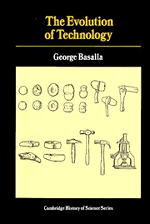Refine search
Actions for selected content:
12661 results in History of science
Chestnut Timber
- from OBSERVATIONS ON VARIOUS PARTS OF NATURE
-
- Book:
- A Naturalist's Calendar
- Published online:
- 05 June 2015
- Print publication:
- 21 August 2014, pp 130-131
-
- Chapter
- Export citation
Hops
- from OBSERVATIONS ON VARIOUS PARTS OF NATURE
-
- Book:
- A Naturalist's Calendar
- Published online:
- 05 June 2015
- Print publication:
- 21 August 2014, pp 133-134
-
- Chapter
- Export citation
Mist, called London Smoke
- from OBSERVATIONS ON VARIOUS PARTS OF NATURE
-
- Book:
- A Naturalist's Calendar
- Published online:
- 05 June 2015
- Print publication:
- 21 August 2014, pp 143-143
-
- Chapter
- Export citation
Beans Sown by Birds
- from OBSERVATIONS ON VARIOUS PARTS OF NATURE
-
- Book:
- A Naturalist's Calendar
- Published online:
- 05 June 2015
- Print publication:
- 21 August 2014, pp 135-135
-
- Chapter
- Export citation
LIST OF BOOKS ON VOLCANOS
-
- Book:
- A Description of Active and Extinct Volcanos
- Published online:
- 05 June 2015
- Print publication:
- 21 August 2014, pp 453-466
-
- Chapter
- Export citation
DIRECTIONS TO THE BINDER
-
- Book:
- A Description of Active and Extinct Volcanos
- Published online:
- 05 June 2015
- Print publication:
- 21 August 2014, pp 468-468
-
- Chapter
- Export citation
Hen Harrier
- from OBSERVATIONS ON VARIOUS PARTS OF NATURE
-
- Book:
- A Naturalist's Calendar
- Published online:
- 05 June 2015
- Print publication:
- 21 August 2014, pp 70-71
-
- Chapter
- Export citation
PREFACE
-
- Book:
- A Description of Active and Extinct Volcanos
- Published online:
- 05 June 2015
- Print publication:
- 21 August 2014, pp vii-x
-
- Chapter
- Export citation
Cucumbers Set by Bees
- from OBSERVATIONS ON VARIOUS PARTS OF NATURE
-
- Book:
- A Naturalist's Calendar
- Published online:
- 05 June 2015
- Print publication:
- 21 August 2014, pp 136-137
-
- Chapter
- Export citation
THE NATURALIST'S CALENDAR
-
- Book:
- A Naturalist's Calendar
- Published online:
- 05 June 2015
- Print publication:
- 21 August 2014, pp 5-6
-
- Chapter
- Export citation
Ash Trees
- from OBSERVATIONS ON VARIOUS PARTS OF NATURE
-
- Book:
- A Naturalist's Calendar
- Published online:
- 05 June 2015
- Print publication:
- 21 August 2014, pp 129-129
-
- Chapter
- Export citation
ROOKS
- from OBSERVATIONS ON VARIOUS PARTS OF NATURE
-
- Book:
- A Naturalist's Calendar
- Published online:
- 05 June 2015
- Print publication:
- 21 August 2014, pp 59-61
-
- Chapter
- Export citation
Wasps
- from OBSERVATIONS ON VARIOUS PARTS OF NATURE
-
- Book:
- A Naturalist's Calendar
- Published online:
- 05 June 2015
- Print publication:
- 21 August 2014, pp 110-111
-
- Chapter
- Export citation
Wild Bee
- from OBSERVATIONS ON VARIOUS PARTS OF NATURE
-
- Book:
- A Naturalist's Calendar
- Published online:
- 05 June 2015
- Print publication:
- 21 August 2014, pp 109-110
-
- Chapter
- Export citation
Dedication
-
- Book:
- A Description of Active and Extinct Volcanos
- Published online:
- 05 June 2015
- Print publication:
- 21 August 2014, pp v-v
-
- Chapter
- Export citation

The Evolution of Technology
-
- Published online:
- 05 August 2014
- Print publication:
- 24 February 1989
SECT. V - THE VALUE OF HIS DISCOVERIES
-
- Book:
- Michael Faraday
- Published online:
- 18 December 2014
- Print publication:
- 17 July 2014, pp 143-163
-
- Chapter
- Export citation
Du gaz de M. de Montgolfier, de la maniere la plus avantageuse de l'obtenir
-
- Book:
- Description des expériences de la machine aérostatique de MM. de Montgolfier
- Published online:
- 18 December 2014
- Print publication:
- 17 July 2014, pp 176-189
-
- Chapter
- Export citation
Contents
-
- Book:
- Description des expériences de la machine aérostatique de MM. de Montgolfier
- Published online:
- 18 December 2014
- Print publication:
- 17 July 2014, pp xxxvi-xxxviii
-
- Chapter
- Export citation
APPROBATION
-
- Book:
- Description des expériences de la machine aérostatique de MM. de Montgolfier
- Published online:
- 18 December 2014
- Print publication:
- 17 July 2014, pp 300-302
-
- Chapter
- Export citation
